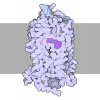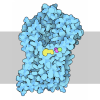[English] 日本語
 Yorodumi
Yorodumi- PDB-9eqg: CryoEM structure of human full-length alpha1beta3gamma2L GABA(A)R... -
+ Open data
Open data
- Basic information
Basic information
| Entry | Database: PDB / ID: 9eqg | ||||||||||||
|---|---|---|---|---|---|---|---|---|---|---|---|---|---|
| Title | CryoEM structure of human full-length alpha1beta3gamma2L GABA(A)R in complex with GABA and puerarin | ||||||||||||
 Components Components | (Gamma-aminobutyric acid receptor subunit ...) x 3 | ||||||||||||
 Keywords Keywords | MEMBRANE PROTEIN / GABA(A) receptor / Inhibitory synapse / GABA / Puerarin / Fat regulation | ||||||||||||
| Function / homology |  Function and homology information Function and homology informationbenzodiazepine receptor activity / GABA receptor complex / cellular response to histamine / GABA receptor activation / GABA-A receptor activity / GABA-gated chloride ion channel activity / GABA-A receptor complex / inhibitory synapse assembly / synaptic transmission, GABAergic / gamma-aminobutyric acid signaling pathway ...benzodiazepine receptor activity / GABA receptor complex / cellular response to histamine / GABA receptor activation / GABA-A receptor activity / GABA-gated chloride ion channel activity / GABA-A receptor complex / inhibitory synapse assembly / synaptic transmission, GABAergic / gamma-aminobutyric acid signaling pathway / postsynaptic specialization membrane / neurotransmitter receptor activity / chloride channel activity / roof of mouth development / adult behavior / Signaling by ERBB4 / transmembrane transporter complex / chloride channel complex / regulation of postsynaptic membrane potential / dendrite membrane / chloride transmembrane transport / GABA-ergic synapse / post-embryonic development / transmitter-gated monoatomic ion channel activity involved in regulation of postsynaptic membrane potential / cytoplasmic vesicle membrane / postsynaptic membrane / dendritic spine / postsynapse / neuron projection / axon / synapse / signal transduction / identical protein binding / plasma membrane Similarity search - Function | ||||||||||||
| Biological species |  Homo sapiens (human) Homo sapiens (human) | ||||||||||||
| Method | ELECTRON MICROSCOPY / single particle reconstruction / cryo EM / Resolution: 2.4 Å | ||||||||||||
 Authors Authors | Kasaragod, V.B. / Aricescu, A.R. | ||||||||||||
| Funding support |  United Kingdom, European Union, 3items United Kingdom, European Union, 3items
| ||||||||||||
 Citation Citation |  Journal: Nature / Year: 2024 Journal: Nature / Year: 2024Title: A brain-to-gut signal controls intestinal fat absorption. Authors: Qianqian Lyu / Wenzhi Xue / Ruixin Liu / Qinyun Ma / Vikram Babu Kasaragod / Shan Sun / Qian Li / Yanru Chen / Mingyang Yuan / Yuying Yang / Bing Zhang / Aifang Nie / Sheng Jia / Chongrong ...Authors: Qianqian Lyu / Wenzhi Xue / Ruixin Liu / Qinyun Ma / Vikram Babu Kasaragod / Shan Sun / Qian Li / Yanru Chen / Mingyang Yuan / Yuying Yang / Bing Zhang / Aifang Nie / Sheng Jia / Chongrong Shen / Po Gao / Weifang Rong / Chenxi Yu / Yufang Bi / Chunlei Zhang / Fajun Nan / Guang Ning / Zihe Rao / Xiuna Yang / Jiqiu Wang / Weiqing Wang /    Abstract: Although fat is a crucial source of energy in diets, excessive intake leads to obesity. Fat absorption in the gut is prevailingly thought to occur organ-autonomously by diffusion. Whether the ...Although fat is a crucial source of energy in diets, excessive intake leads to obesity. Fat absorption in the gut is prevailingly thought to occur organ-autonomously by diffusion. Whether the process is controlled by the brain-to-gut axis, however, remains largely unknown. Here we demonstrate that the dorsal motor nucleus of vagus (DMV) plays a key part in this process. Inactivation of DMV neurons reduces intestinal fat absorption and consequently causes weight loss, whereas activation of the DMV increases fat absorption and weight gain. Notably, the inactivation of a subpopulation of DMV neurons that project to the jejunum shortens the length of microvilli, thereby reducing fat absorption. Moreover, we identify a natural compound, puerarin, that mimics the suppression of the DMV-vagus pathway, which in turn leads to reduced fat absorption. Photoaffinity chemical methods and cryogenic electron microscopy of the structure of a GABA receptor-puerarin complex reveal that puerarin binds to an allosteric modulatory site. Notably, conditional Gabra1 knockout in the DMV largely abolishes puerarin-induced intestinal fat loss. In summary, we discover that suppression of the DMV-vagus-jejunum axis controls intestinal fat absorption by shortening the length of microvilli and illustrate the therapeutic potential of puerarin binding to GABRA1 in fat loss. | ||||||||||||
| History |
|
- Structure visualization
Structure visualization
| Structure viewer | Molecule:  Molmil Molmil Jmol/JSmol Jmol/JSmol |
|---|
- Downloads & links
Downloads & links
- Download
Download
| PDBx/mmCIF format |  9eqg.cif.gz 9eqg.cif.gz | 376.3 KB | Display |  PDBx/mmCIF format PDBx/mmCIF format |
|---|---|---|---|---|
| PDB format |  pdb9eqg.ent.gz pdb9eqg.ent.gz | Display |  PDB format PDB format | |
| PDBx/mmJSON format |  9eqg.json.gz 9eqg.json.gz | Tree view |  PDBx/mmJSON format PDBx/mmJSON format | |
| Others |  Other downloads Other downloads |
-Validation report
| Summary document |  9eqg_validation.pdf.gz 9eqg_validation.pdf.gz | 2.3 MB | Display |  wwPDB validaton report wwPDB validaton report |
|---|---|---|---|---|
| Full document |  9eqg_full_validation.pdf.gz 9eqg_full_validation.pdf.gz | 2.2 MB | Display | |
| Data in XML |  9eqg_validation.xml.gz 9eqg_validation.xml.gz | 71.2 KB | Display | |
| Data in CIF |  9eqg_validation.cif.gz 9eqg_validation.cif.gz | 106.8 KB | Display | |
| Arichive directory |  https://data.pdbj.org/pub/pdb/validation_reports/eq/9eqg https://data.pdbj.org/pub/pdb/validation_reports/eq/9eqg ftp://data.pdbj.org/pub/pdb/validation_reports/eq/9eqg ftp://data.pdbj.org/pub/pdb/validation_reports/eq/9eqg | HTTPS FTP |
-Related structure data
| Related structure data |  19907MC M: map data used to model this data C: citing same article ( |
|---|---|
| Similar structure data | Similarity search - Function & homology  F&H Search F&H Search |
- Links
Links
- Assembly
Assembly
| Deposited unit | 
|
|---|---|
| 1 |
|
- Components
Components
-Gamma-aminobutyric acid receptor subunit ... , 3 types, 5 molecules ADBEC
| #1: Protein | Mass: 52916.602 Da / Num. of mol.: 2 Source method: isolated from a genetically manipulated source Source: (gene. exp.)  Homo sapiens (human) / Gene: GABRA1 / Cell line (production host): HEK293S / Production host: Homo sapiens (human) / Gene: GABRA1 / Cell line (production host): HEK293S / Production host:  Homo sapiens (human) / References: UniProt: P14867 Homo sapiens (human) / References: UniProt: P14867#2: Protein | Mass: 54180.348 Da / Num. of mol.: 2 Source method: isolated from a genetically manipulated source Source: (gene. exp.)  Homo sapiens (human) / Gene: GABRB3 / Cell line (production host): HEK293S / Production host: Homo sapiens (human) / Gene: GABRB3 / Cell line (production host): HEK293S / Production host:  Homo sapiens (human) / References: UniProt: P28472 Homo sapiens (human) / References: UniProt: P28472#3: Protein | | Mass: 56922.055 Da / Num. of mol.: 1 Source method: isolated from a genetically manipulated source Source: (gene. exp.)  Homo sapiens (human) / Gene: GABRG2 / Cell line (production host): HEK293S / Production host: Homo sapiens (human) / Gene: GABRG2 / Cell line (production host): HEK293S / Production host:  Homo sapiens (human) / References: UniProt: P18507 Homo sapiens (human) / References: UniProt: P18507 |
|---|
-Sugars , 4 types, 7 molecules 
| #4: Polysaccharide | alpha-D-mannopyranose-(1-2)-alpha-D-mannopyranose-(1-2)-alpha-D-mannopyranose-(1-3)-[alpha-D- ...alpha-D-mannopyranose-(1-2)-alpha-D-mannopyranose-(1-2)-alpha-D-mannopyranose-(1-3)-[alpha-D-mannopyranose-(1-2)-alpha-D-mannopyranose-(1-6)-[alpha-D-mannopyranose-(1-3)]alpha-D-mannopyranose-(1-6)]beta-D-mannopyranose-(1-4)-2-acetamido-2-deoxy-beta-D-glucopyranose-(1-4)-2-acetamido-2-deoxy-beta-D-glucopyranose Source method: isolated from a genetically manipulated source | ||||
|---|---|---|---|---|---|
| #5: Polysaccharide | Source method: isolated from a genetically manipulated source #6: Polysaccharide | Source method: isolated from a genetically manipulated source #15: Sugar | ChemComp-NAG / | |
-Non-polymers , 11 types, 298 molecules 


















| #7: Chemical | | #8: Chemical | ChemComp-D10 / #9: Chemical | ChemComp-HEX / #10: Chemical | #11: Chemical | ChemComp-R16 / #12: Chemical | #13: Chemical | #14: Chemical | #16: Chemical | ChemComp-A1H6W / | Mass: 416.378 Da / Num. of mol.: 1 Source method: isolated from a genetically manipulated source Formula: C21H20O9 / Feature type: SUBJECT OF INVESTIGATION #17: Chemical | ChemComp-PX2 / | #18: Water | ChemComp-HOH / | |
|---|
-Details
| Has ligand of interest | Y |
|---|---|
| Has protein modification | Y |
-Experimental details
-Experiment
| Experiment | Method: ELECTRON MICROSCOPY |
|---|---|
| EM experiment | Aggregation state: PARTICLE / 3D reconstruction method: single particle reconstruction |
- Sample preparation
Sample preparation
| Component | Name: CryoEM structure of human full-length alpha1beta3gamma2L GABA(A)R in complex with GABA and puerarin Type: COMPLEX / Entity ID: #1-#3 / Source: RECOMBINANT | |||||||||||||||
|---|---|---|---|---|---|---|---|---|---|---|---|---|---|---|---|---|
| Molecular weight | Value: 0.25 MDa / Experimental value: NO | |||||||||||||||
| Source (natural) | Organism:  Homo sapiens (human) Homo sapiens (human) | |||||||||||||||
| Source (recombinant) | Organism:  Homo sapiens (human) / Cell: HEK293S Homo sapiens (human) / Cell: HEK293S | |||||||||||||||
| Buffer solution | pH: 7.4 / Details: 15 mM Hepes pH 7.4, 100 mM NaCl | |||||||||||||||
| Buffer component |
| |||||||||||||||
| Specimen | Conc.: 1 mg/ml / Embedding applied: NO / Shadowing applied: NO / Staining applied: NO / Vitrification applied: YES | |||||||||||||||
| Specimen support | Grid material: GOLD / Grid mesh size: 300 divisions/in. / Grid type: UltrAuFoil R1.2/1.3 | |||||||||||||||
| Vitrification | Instrument: LEICA EM GP / Cryogen name: ETHANE / Humidity: 95 % / Chamber temperature: 287 K |
- Electron microscopy imaging
Electron microscopy imaging
| Experimental equipment |  Model: Titan Krios / Image courtesy: FEI Company |
|---|---|
| Microscopy | Model: TFS KRIOS |
| Electron gun | Electron source:  FIELD EMISSION GUN / Accelerating voltage: 300 kV / Illumination mode: FLOOD BEAM FIELD EMISSION GUN / Accelerating voltage: 300 kV / Illumination mode: FLOOD BEAM |
| Electron lens | Mode: BRIGHT FIELD / Nominal magnification: 96000 X / Calibrated magnification: 96000 X / Nominal defocus max: 2400 nm / Nominal defocus min: 1000 nm / Calibrated defocus min: 500 nm / Calibrated defocus max: 3500 nm / Cs: 2.7 mm / C2 aperture diameter: 50 µm / Alignment procedure: COMA FREE |
| Specimen holder | Cryogen: NITROGEN / Specimen holder model: FEI TITAN KRIOS AUTOGRID HOLDER / Temperature (max): 84 K / Temperature (min): 84 K |
| Image recording | Average exposure time: 4.19 sec. / Electron dose: 40 e/Å2 / Film or detector model: TFS FALCON 4i (4k x 4k) / Num. of grids imaged: 1 / Num. of real images: 8747 |
| Image scans | Width: 4096 / Height: 4096 |
- Processing
Processing
| EM software |
| ||||||||||||||||||||||||||||||||||||
|---|---|---|---|---|---|---|---|---|---|---|---|---|---|---|---|---|---|---|---|---|---|---|---|---|---|---|---|---|---|---|---|---|---|---|---|---|---|
| CTF correction | Type: PHASE FLIPPING AND AMPLITUDE CORRECTION | ||||||||||||||||||||||||||||||||||||
| Particle selection | Num. of particles selected: 1932720 | ||||||||||||||||||||||||||||||||||||
| Symmetry | Point symmetry: C1 (asymmetric) | ||||||||||||||||||||||||||||||||||||
| 3D reconstruction | Resolution: 2.4 Å / Resolution method: FSC 0.143 CUT-OFF / Num. of particles: 122065 / Algorithm: FOURIER SPACE / Symmetry type: POINT | ||||||||||||||||||||||||||||||||||||
| Atomic model building | B value: 10 / Protocol: OTHER / Space: REAL / Target criteria: FSC at 0.5 / Details: Real space refinement with ADP correction. | ||||||||||||||||||||||||||||||||||||
| Atomic model building | PDB-ID: 6HUP Accession code: 6HUP / Source name: PDB / Type: experimental model | ||||||||||||||||||||||||||||||||||||
| Refine LS restraints |
|
 Movie
Movie Controller
Controller


 PDBj
PDBj


















